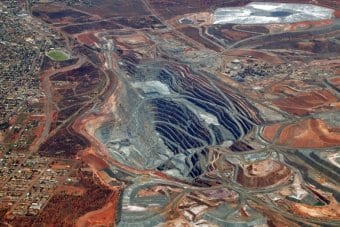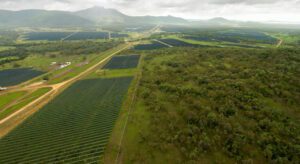In the face of budget cuts, ARENA is continuing with its program to foster the development of renewable energy projects to supply the mining industry. With multiple gigawatts of new generating capacity expected to be required to supply the growing industry in the coming years, renewables for resources presents a major opportunity to the sector. It also provides a chance for miners to save cash and reduce greenhouse emissions.
The size of the opportunity presented in regional Australia for renewable energy development, particularly from the resources sector, is considerable. A recent report from the Bureau of Resources and Energy Economics found that in 2011-12, 6 per cent – or 15,812 GWh – of Australia’s electricity demand came from outside of the NEW and SWIS grids. The mining industry is responsible for some 77 per cent of this – 12,202 GWh, with electricity demand expected to grow as the resource and energy sector itself grows.
The Bureau complied the data in the “Beyond the NEM and SWIS…” report, which was released in October. It noted that Western Australia accounts for 56% of Australia’s off-grid electricity demand, or 8,882 GWh. The high proportion of demand in WA is expected to continue, the report notes, with 28 resources and energy projects in the state, “at the commitment stage”.
It is therefore no surprise that ARENA held its Resources and Renewable Energy Forum in Perth on November 4. The Chamber of Minerals and Energy hosted the forum and it showcased the opportunities for developing renewable energy projects to supply mining operations under ARENA’s Regional Australia’s Renewables – Industry Program. Under the scheme, regional businesses can apply for a range of support mechanisms from ARENA to realise renewable energy developments. ARENA CEO Ivor Frischknecht said that upfront capital grants, revenue-based support and contingent or risk-sharing grants for the projects are being considered.
ARENA is taking submissions until the end of December for the program and CEO Frischknecht said that the body has already received a large number of submissions from minerals extraction companies and gas companies. “We have a large pipeline that we’re looking at,” said Frischknecht, “in terms of project value it’s several billion dollars – not all of which will come through of course.” Frischnecht said that as the projects are large and require a range of environmental and native title approvals that the earliest construction of any projects could take place would be in the latter half of 2014.
Good renewable fit
Renewable energy sources can provide electricity to resource projects in a range of different ways. For gas processing operations, notes ARENA’s Frischknecht, concentrated solar power (CSP) or solar thermal is a particularly good fit, as gas processing requires “relatively low grade heat.” ARENA is currently looking at projects, under its development scheme, that could include CSP, PV or wind. “In all cases there are fairly low levels of penetration, so the (resource operations) would all continue to use whatever fossil fuel they were using beforehand, but the benefit is that as these businesses start using renewables and see the cost savings come through, then over time that penetration rate will increase.”
At the Resources Energy Forum event, experiences from renewables for resources projects from elsewhere in the world were shared. A representative from Rio Tinto’s Diavik mine Canada, spoke about its wind project, which achieves up to a 50% peak penetration rate; Abengoa U.S., presented results from its solar thermal project in the Atacama desert in Chile; and SMA set out the key for successful integration of solar PV into diesel and gas generators, referring to an existing South African project.
At present Chile is proving to be a particular bright spot in terms of solar PV development in the northern regions. Large multi-MW projects are currently being developed, using ground mounted PV arrays.
“These mining operations are trail blazers,” said Frischnecht. “This is a conservative industry that is focused on its core business, but having said that I think the renewable business case is often there.” The payback times, ARENA reports, for the three renewable energy developments featured at the Forum ranged between 3.5 to 8 years. Frischnecht sums it up: “In those cases they made it work, the renewables, unsubsidized were simply cheaper.”
Business case for renewables
Off-grid mining operations in Australia tend to have electricity supplied either through diesel generation or through gas pipelines. At the diesel-supplied sites, ARENA estimates costs of around $200/MWh to $500/MWh, while at the pipeline-supplied sites around $100/MWh.
The former head of Perth-based Sustainable Energy Association (SEA) Ray Wills said that the diesel market alone presents a billion-dollar opportunity for renewable energy. “With over one hundred mine sites chewing 700 MW diesel a year, that’s a potential $2 billion market in WA alone,” said Wills. “The metric is that every 1 MW of solar would save almost 500 000 litres of diesel.”
Despite the conservative nature of the resource industry, another barrier entry for renewables is reliability. “Remote conventional generation arguably only gives 97% reliability with diesel generation and similar from gas generation, and miners would be happy with anything north of that,” said Wills. “In my opinion, if some pilot operations can demonstrate cost savings and superior reliability there is not a miner in the nation that wouldn’t convert.”
Wills said that, in light of this, ARENA is wise to be putting funding towards getting such pilot projects off the ground.
Another challenge to this promising field of renewable development is that mine lives can be relatively short. ARENA is working on providing a form of support in the event of a mine closing, before a renewable investment is fully amortized. “You can imagine that if the mine only has a five-year planning life and in renewables that have a ten-year payback, if the mine does actually close before ten years – we (ARENA) could provide a grant to pay for it, so that the project still pans out,” said Frischnecht. “Knowing full well, of course, that the majority of these mines do go on beyond the five years.”
The Chamber of Minerals and Energy said that it is currently working with Austrade and ARENA on a publication, “to inform renewable energy proponents seeking to develop partnerships with resource sector companies.” Reneweconomy contacted the Chamber for further comment without success.








